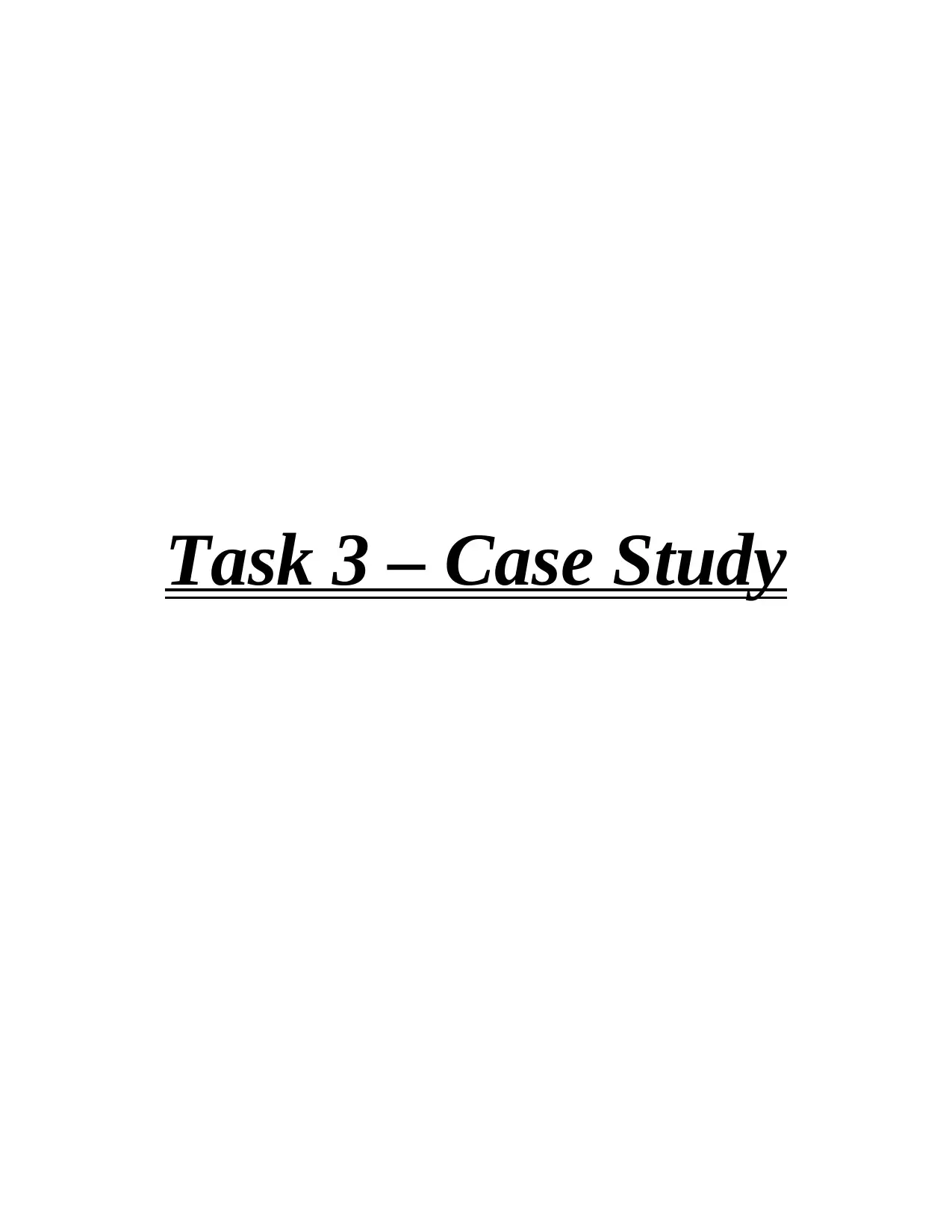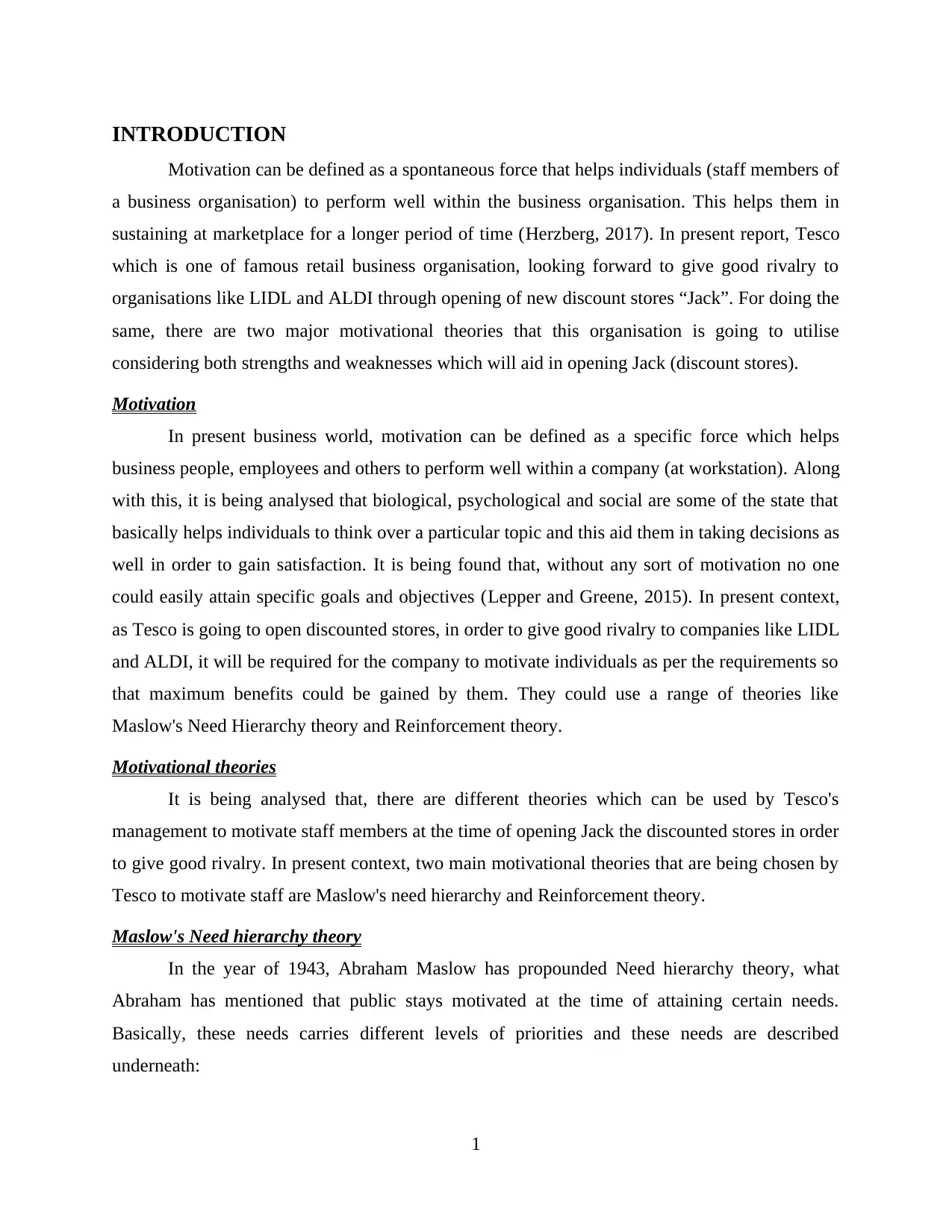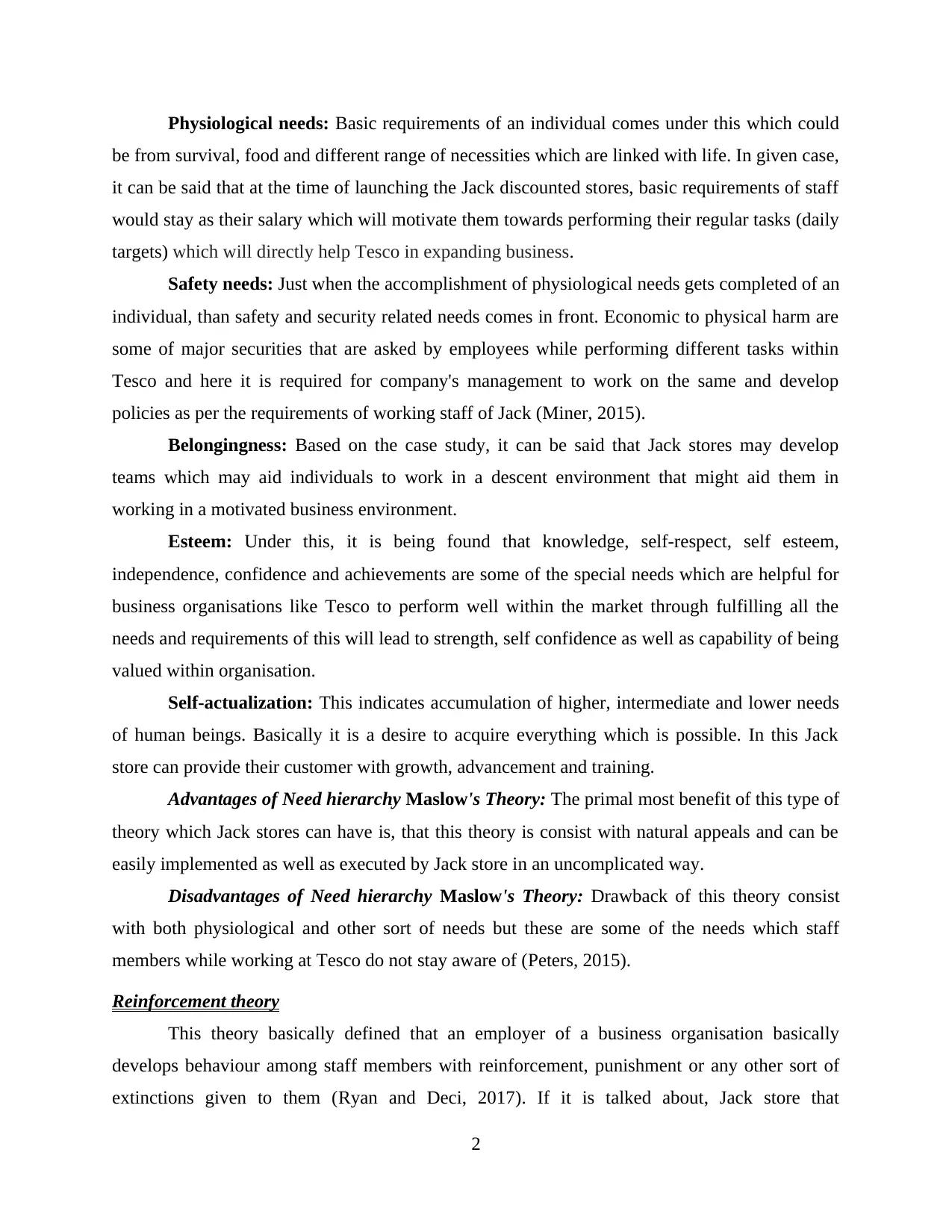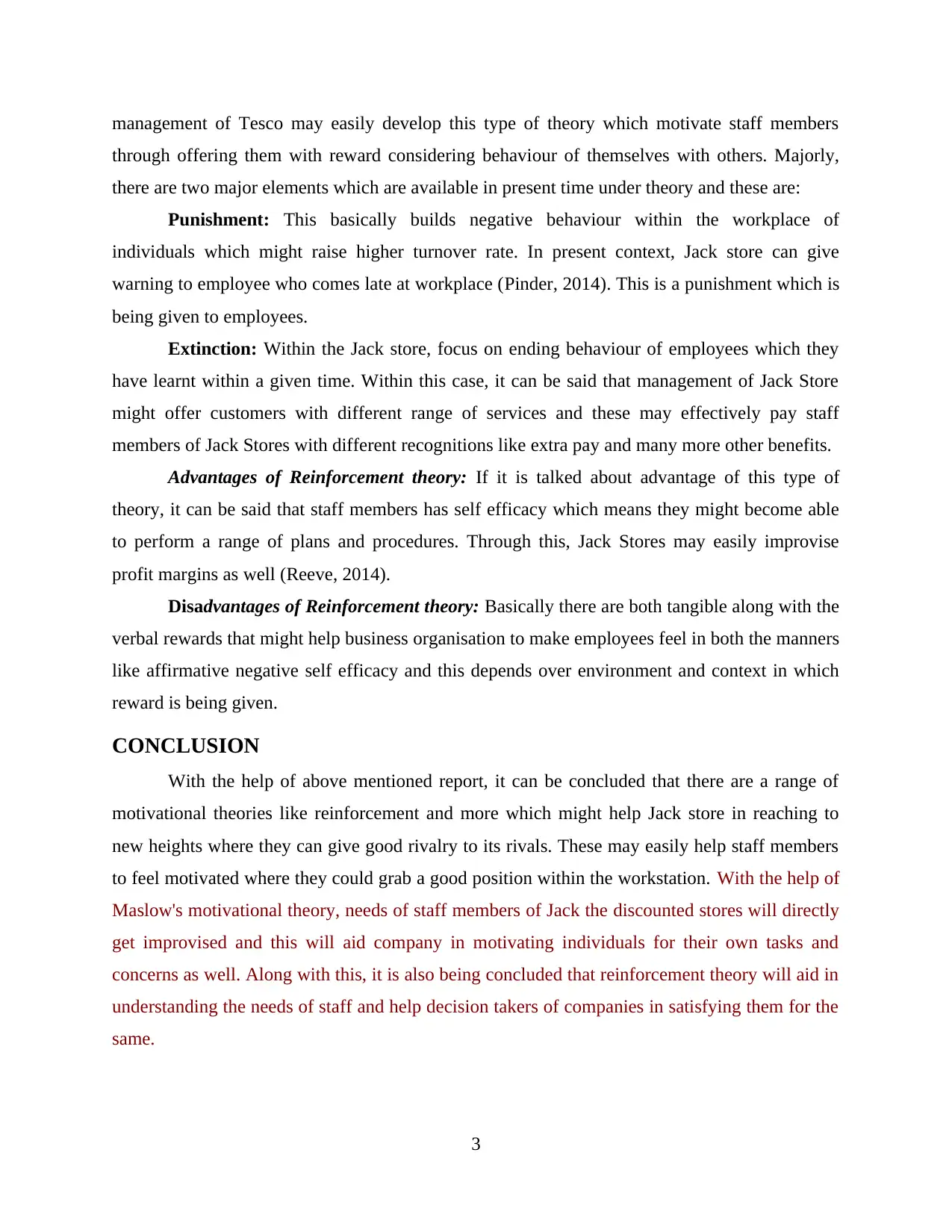Case Study Analysis: Applying Motivational Theories at Jack Stores
VerifiedAdded on 2020/10/22
|7
|1531
|60
Case Study
AI Summary
This case study examines the application of motivational theories within Tesco's Jack discount stores, focusing on how these strategies enhance employee performance and competitiveness against rivals like LIDL and ALDI. The analysis delves into two key theories: Maslow's Need Hierarchy and Reinforcement theory. The study explores how Jack stores can utilize Maslow's framework to address employees' physiological, safety, belongingness, esteem, and self-actualization needs, thereby boosting motivation. Additionally, it investigates the use of reinforcement theory, including both positive and negative reinforcements, to shape employee behavior and improve outcomes. The case study concludes that the effective implementation of these theories is crucial for Jack stores to achieve their business objectives, improve employee satisfaction, and maintain a competitive edge in the retail market. The report provides insights on how these theories contribute to better management practices and decision-making within the organization, ultimately driving business success.

Task 3 – Case Study
Paraphrase This Document
Need a fresh take? Get an instant paraphrase of this document with our AI Paraphraser

EXECUTIVE SUMMARY
Present document has showed a range of motivational theories, that has helped business
organisation (Jack - The new discount stores) in giving good rivalry to companies like LIDL and
ASDA. This has managed to improvise efficiency level of employees that TESCO has shifted in
Jack Stores. Along with this, it can be said that Maslow's Need hierarchy theory, Reinforcement
theory and more has helped in managing the manpower of TESCO Plc while expanding business
to gain competitive advancements.
Present document has showed a range of motivational theories, that has helped business
organisation (Jack - The new discount stores) in giving good rivalry to companies like LIDL and
ASDA. This has managed to improvise efficiency level of employees that TESCO has shifted in
Jack Stores. Along with this, it can be said that Maslow's Need hierarchy theory, Reinforcement
theory and more has helped in managing the manpower of TESCO Plc while expanding business
to gain competitive advancements.

Table of Contents
EXECUTIVE SUMMARY.............................................................................................................2
INTRODUCTION...........................................................................................................................1
Motivation..............................................................................................................................1
Motivational theories..............................................................................................................1
Maslow's Need hierarchy theory............................................................................................1
Reinforcement theory.............................................................................................................2
CONCLUSION................................................................................................................................3
REFERENCES................................................................................................................................4
EXECUTIVE SUMMARY.............................................................................................................2
INTRODUCTION...........................................................................................................................1
Motivation..............................................................................................................................1
Motivational theories..............................................................................................................1
Maslow's Need hierarchy theory............................................................................................1
Reinforcement theory.............................................................................................................2
CONCLUSION................................................................................................................................3
REFERENCES................................................................................................................................4
⊘ This is a preview!⊘
Do you want full access?
Subscribe today to unlock all pages.

Trusted by 1+ million students worldwide

INTRODUCTION
Motivation can be defined as a spontaneous force that helps individuals (staff members of
a business organisation) to perform well within the business organisation. This helps them in
sustaining at marketplace for a longer period of time (Herzberg, 2017). In present report, Tesco
which is one of famous retail business organisation, looking forward to give good rivalry to
organisations like LIDL and ALDI through opening of new discount stores “Jack”. For doing the
same, there are two major motivational theories that this organisation is going to utilise
considering both strengths and weaknesses which will aid in opening Jack (discount stores).
Motivation
In present business world, motivation can be defined as a specific force which helps
business people, employees and others to perform well within a company (at workstation). Along
with this, it is being analysed that biological, psychological and social are some of the state that
basically helps individuals to think over a particular topic and this aid them in taking decisions as
well in order to gain satisfaction. It is being found that, without any sort of motivation no one
could easily attain specific goals and objectives (Lepper and Greene, 2015). In present context,
as Tesco is going to open discounted stores, in order to give good rivalry to companies like LIDL
and ALDI, it will be required for the company to motivate individuals as per the requirements so
that maximum benefits could be gained by them. They could use a range of theories like
Maslow's Need Hierarchy theory and Reinforcement theory.
Motivational theories
It is being analysed that, there are different theories which can be used by Tesco's
management to motivate staff members at the time of opening Jack the discounted stores in order
to give good rivalry. In present context, two main motivational theories that are being chosen by
Tesco to motivate staff are Maslow's need hierarchy and Reinforcement theory.
Maslow's Need hierarchy theory
In the year of 1943, Abraham Maslow has propounded Need hierarchy theory, what
Abraham has mentioned that public stays motivated at the time of attaining certain needs.
Basically, these needs carries different levels of priorities and these needs are described
underneath:
1
Motivation can be defined as a spontaneous force that helps individuals (staff members of
a business organisation) to perform well within the business organisation. This helps them in
sustaining at marketplace for a longer period of time (Herzberg, 2017). In present report, Tesco
which is one of famous retail business organisation, looking forward to give good rivalry to
organisations like LIDL and ALDI through opening of new discount stores “Jack”. For doing the
same, there are two major motivational theories that this organisation is going to utilise
considering both strengths and weaknesses which will aid in opening Jack (discount stores).
Motivation
In present business world, motivation can be defined as a specific force which helps
business people, employees and others to perform well within a company (at workstation). Along
with this, it is being analysed that biological, psychological and social are some of the state that
basically helps individuals to think over a particular topic and this aid them in taking decisions as
well in order to gain satisfaction. It is being found that, without any sort of motivation no one
could easily attain specific goals and objectives (Lepper and Greene, 2015). In present context,
as Tesco is going to open discounted stores, in order to give good rivalry to companies like LIDL
and ALDI, it will be required for the company to motivate individuals as per the requirements so
that maximum benefits could be gained by them. They could use a range of theories like
Maslow's Need Hierarchy theory and Reinforcement theory.
Motivational theories
It is being analysed that, there are different theories which can be used by Tesco's
management to motivate staff members at the time of opening Jack the discounted stores in order
to give good rivalry. In present context, two main motivational theories that are being chosen by
Tesco to motivate staff are Maslow's need hierarchy and Reinforcement theory.
Maslow's Need hierarchy theory
In the year of 1943, Abraham Maslow has propounded Need hierarchy theory, what
Abraham has mentioned that public stays motivated at the time of attaining certain needs.
Basically, these needs carries different levels of priorities and these needs are described
underneath:
1
Paraphrase This Document
Need a fresh take? Get an instant paraphrase of this document with our AI Paraphraser

Physiological needs: Basic requirements of an individual comes under this which could
be from survival, food and different range of necessities which are linked with life. In given case,
it can be said that at the time of launching the Jack discounted stores, basic requirements of staff
would stay as their salary which will motivate them towards performing their regular tasks (daily
targets) which will directly help Tesco in expanding business.
Safety needs: Just when the accomplishment of physiological needs gets completed of an
individual, than safety and security related needs comes in front. Economic to physical harm are
some of major securities that are asked by employees while performing different tasks within
Tesco and here it is required for company's management to work on the same and develop
policies as per the requirements of working staff of Jack (Miner, 2015).
Belongingness: Based on the case study, it can be said that Jack stores may develop
teams which may aid individuals to work in a descent environment that might aid them in
working in a motivated business environment.
Esteem: Under this, it is being found that knowledge, self-respect, self esteem,
independence, confidence and achievements are some of the special needs which are helpful for
business organisations like Tesco to perform well within the market through fulfilling all the
needs and requirements of this will lead to strength, self confidence as well as capability of being
valued within organisation.
Self-actualization: This indicates accumulation of higher, intermediate and lower needs
of human beings. Basically it is a desire to acquire everything which is possible. In this Jack
store can provide their customer with growth, advancement and training.
Advantages of Need hierarchy Maslow's Theory: The primal most benefit of this type of
theory which Jack stores can have is, that this theory is consist with natural appeals and can be
easily implemented as well as executed by Jack store in an uncomplicated way.
Disadvantages of Need hierarchy Maslow's Theory: Drawback of this theory consist
with both physiological and other sort of needs but these are some of the needs which staff
members while working at Tesco do not stay aware of (Peters, 2015).
Reinforcement theory
This theory basically defined that an employer of a business organisation basically
develops behaviour among staff members with reinforcement, punishment or any other sort of
extinctions given to them (Ryan and Deci, 2017). If it is talked about, Jack store that
2
be from survival, food and different range of necessities which are linked with life. In given case,
it can be said that at the time of launching the Jack discounted stores, basic requirements of staff
would stay as their salary which will motivate them towards performing their regular tasks (daily
targets) which will directly help Tesco in expanding business.
Safety needs: Just when the accomplishment of physiological needs gets completed of an
individual, than safety and security related needs comes in front. Economic to physical harm are
some of major securities that are asked by employees while performing different tasks within
Tesco and here it is required for company's management to work on the same and develop
policies as per the requirements of working staff of Jack (Miner, 2015).
Belongingness: Based on the case study, it can be said that Jack stores may develop
teams which may aid individuals to work in a descent environment that might aid them in
working in a motivated business environment.
Esteem: Under this, it is being found that knowledge, self-respect, self esteem,
independence, confidence and achievements are some of the special needs which are helpful for
business organisations like Tesco to perform well within the market through fulfilling all the
needs and requirements of this will lead to strength, self confidence as well as capability of being
valued within organisation.
Self-actualization: This indicates accumulation of higher, intermediate and lower needs
of human beings. Basically it is a desire to acquire everything which is possible. In this Jack
store can provide their customer with growth, advancement and training.
Advantages of Need hierarchy Maslow's Theory: The primal most benefit of this type of
theory which Jack stores can have is, that this theory is consist with natural appeals and can be
easily implemented as well as executed by Jack store in an uncomplicated way.
Disadvantages of Need hierarchy Maslow's Theory: Drawback of this theory consist
with both physiological and other sort of needs but these are some of the needs which staff
members while working at Tesco do not stay aware of (Peters, 2015).
Reinforcement theory
This theory basically defined that an employer of a business organisation basically
develops behaviour among staff members with reinforcement, punishment or any other sort of
extinctions given to them (Ryan and Deci, 2017). If it is talked about, Jack store that
2

management of Tesco may easily develop this type of theory which motivate staff members
through offering them with reward considering behaviour of themselves with others. Majorly,
there are two major elements which are available in present time under theory and these are:
Punishment: This basically builds negative behaviour within the workplace of
individuals which might raise higher turnover rate. In present context, Jack store can give
warning to employee who comes late at workplace (Pinder, 2014). This is a punishment which is
being given to employees.
Extinction: Within the Jack store, focus on ending behaviour of employees which they
have learnt within a given time. Within this case, it can be said that management of Jack Store
might offer customers with different range of services and these may effectively pay staff
members of Jack Stores with different recognitions like extra pay and many more other benefits.
Advantages of Reinforcement theory: If it is talked about advantage of this type of
theory, it can be said that staff members has self efficacy which means they might become able
to perform a range of plans and procedures. Through this, Jack Stores may easily improvise
profit margins as well (Reeve, 2014).
Disadvantages of Reinforcement theory: Basically there are both tangible along with the
verbal rewards that might help business organisation to make employees feel in both the manners
like affirmative negative self efficacy and this depends over environment and context in which
reward is being given.
CONCLUSION
With the help of above mentioned report, it can be concluded that there are a range of
motivational theories like reinforcement and more which might help Jack store in reaching to
new heights where they can give good rivalry to its rivals. These may easily help staff members
to feel motivated where they could grab a good position within the workstation. With the help of
Maslow's motivational theory, needs of staff members of Jack the discounted stores will directly
get improvised and this will aid company in motivating individuals for their own tasks and
concerns as well. Along with this, it is also being concluded that reinforcement theory will aid in
understanding the needs of staff and help decision takers of companies in satisfying them for the
same.
3
through offering them with reward considering behaviour of themselves with others. Majorly,
there are two major elements which are available in present time under theory and these are:
Punishment: This basically builds negative behaviour within the workplace of
individuals which might raise higher turnover rate. In present context, Jack store can give
warning to employee who comes late at workplace (Pinder, 2014). This is a punishment which is
being given to employees.
Extinction: Within the Jack store, focus on ending behaviour of employees which they
have learnt within a given time. Within this case, it can be said that management of Jack Store
might offer customers with different range of services and these may effectively pay staff
members of Jack Stores with different recognitions like extra pay and many more other benefits.
Advantages of Reinforcement theory: If it is talked about advantage of this type of
theory, it can be said that staff members has self efficacy which means they might become able
to perform a range of plans and procedures. Through this, Jack Stores may easily improvise
profit margins as well (Reeve, 2014).
Disadvantages of Reinforcement theory: Basically there are both tangible along with the
verbal rewards that might help business organisation to make employees feel in both the manners
like affirmative negative self efficacy and this depends over environment and context in which
reward is being given.
CONCLUSION
With the help of above mentioned report, it can be concluded that there are a range of
motivational theories like reinforcement and more which might help Jack store in reaching to
new heights where they can give good rivalry to its rivals. These may easily help staff members
to feel motivated where they could grab a good position within the workstation. With the help of
Maslow's motivational theory, needs of staff members of Jack the discounted stores will directly
get improvised and this will aid company in motivating individuals for their own tasks and
concerns as well. Along with this, it is also being concluded that reinforcement theory will aid in
understanding the needs of staff and help decision takers of companies in satisfying them for the
same.
3
⊘ This is a preview!⊘
Do you want full access?
Subscribe today to unlock all pages.

Trusted by 1+ million students worldwide

REFERENCES
Books & Journals
Herzberg, F., 2017. Motivation to work. Routledge.
Lepper, M. R. and Greene, D. eds., 2015. The hidden costs of reward: New perspectives on the
psychology of human motivation. Psychology Press.
Miner, J. B., 2015. Organizational behavior 1: Essential theories of motivation and leadership.
Routledge.
Peters, R. S., 2015. The concept of motivation. Routledge.
Pinder, C. C., 2014. Work motivation in organizational behavior. Psychology Press.
Reeve, J., 2014. Understanding motivation and emotion. John Wiley & Sons.
Ryan, R. M. and Deci, E. L., 2017. Self-determination theory: Basic psychological needs in
motivation, development, and wellness. Guilford Publications.
4
Books & Journals
Herzberg, F., 2017. Motivation to work. Routledge.
Lepper, M. R. and Greene, D. eds., 2015. The hidden costs of reward: New perspectives on the
psychology of human motivation. Psychology Press.
Miner, J. B., 2015. Organizational behavior 1: Essential theories of motivation and leadership.
Routledge.
Peters, R. S., 2015. The concept of motivation. Routledge.
Pinder, C. C., 2014. Work motivation in organizational behavior. Psychology Press.
Reeve, J., 2014. Understanding motivation and emotion. John Wiley & Sons.
Ryan, R. M. and Deci, E. L., 2017. Self-determination theory: Basic psychological needs in
motivation, development, and wellness. Guilford Publications.
4
1 out of 7
Related Documents
Your All-in-One AI-Powered Toolkit for Academic Success.
+13062052269
info@desklib.com
Available 24*7 on WhatsApp / Email
![[object Object]](/_next/static/media/star-bottom.7253800d.svg)
Unlock your academic potential
Copyright © 2020–2025 A2Z Services. All Rights Reserved. Developed and managed by ZUCOL.





